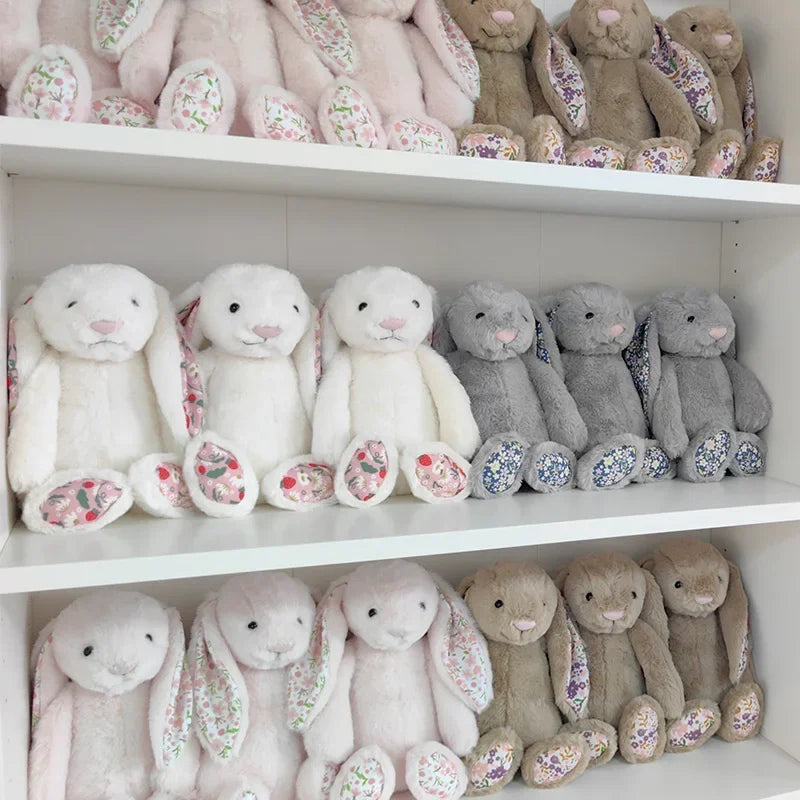
Why Jellycat Plushes Are Taking Over Hearts (and TikTok Feeds)
Share
If adorable, ultra-soft, and quirky could merge into a single entity, you’d have a Jellycat plush; time-tested cuddle companions that have bounced from bedtime to brunch dates on TikTok. But they're more than a viral fad. Ready to dive into what makes these plushies absolute legends? Let’s go!
1. A Quirky Beginning That Sparked a Soft Empire
Founded in London in 1999 by brothers Thomas and William Gatacre, Jellycat started as a dream to create plush toys that weren’t just teddy-bear cliches, think more “jelly + cat” whimsy. And just like that, a legend was born.
From the early 2000s, Jellycat blossomed with its signature softness, bold designs (including smiling food and floppy bunnies), and rigorous safety standards that made them baby-safe favorites.
2. From Bashful Bunny to Global Cuteness Icon
Sure, the Bashful Bunny is iconic; floppy-eared, plushy perfection in multiple sizes. It’s often the gateway drug to the Jellycat collector’s world.
But the real secret sauce? The Amuseables; happy food, veggies, and oddball plush designs that make your heart go “uh… awww.” Collecting one means getting sucked into wanting them all.
3. Now Featuring: Adults, Kidults & Gen Z Plush Obsession
Once seen as toddler toys, Jellycats now occupy office desks, college dorms, and therapy sessions. A Jaw-dropping 58% boost in British sales since 2021 highlights plushie purchases are no longer just for kids. Adults—especially Gen Z—are major fans.
It’s not just about nostalgia. These plushies serve as emotional support, grounding objects—yes, even in therapy sessions.
4. Social Media & Strategic Scarcity: A Perfect Plush Storm
#TikTok is lit with Jellycat hauls, memes, and realistic editing panning shots. The hashtag alone racks up millions of views.
Meanwhile, Jellycat practices smart scarcity—retiring designs regularly, releasing limited editions, and strategically limiting supply. This keeps collectors on their toes and markets hot
5. A Global Plush Empire: Revenue, Reach & Rarity
By 2023, Jellycat was making noise with £200 million in UK sales and a valuation around £58 million.
In fact, by the same year, their plush toys were selling in over 80 countries, and the brand’s footprint included immersive Jellycat cafes and pop-ups.
6. The Dark Side of Softness: Crime, Scalpers & Real Drama
When something becomes Instagrammable, collectable, and scarce, theft becomes real. In recent years, Jellycats have been shoplifted en masse—leading to CCTV, facial-recognition measures, and a mini black market for rare plushies.
Some rare plushies even go for hundreds—or thousands—on resale platforms. One ambitious collector sold a single Jellycat for £720 to fund a home deposit.
Frequently Asked Questions (FAQ)
Q: Why are Jellycat plushes so popular now?
A: Mix epic softness, quirky designs, strategic scarcity, and TikTok magic, and you get a triumphant plush resurgence.
Q: What's the most iconic Jellycat?
A: The Bashful Bunny—it’s soft, floppy, countless colorways, and serves as the plush entry point for many.
Q: Are Jellycats safe for babies?
A: Indeed! Many are baby-safe from birth (quality materials, safety-tested), scoring top marks with parents.
Q: Are they worth collecting like Beanie Babies?
A: For many, yes. Limited runs and retired designs make select Jellycats highly collectible—and occasionally, pricey.
Q: Where can I find rare or retired Jellycats?
A: Online marketplaces, collector forums, and niche retailers—just be ready to splash some cash.
Why Jellycat Plushies Are Here to Stay
- Historically rooted in whimsical London beginnings (1999)
- Culturally addictive, bridging babies and plush-loving adults alike
- Social-media famous, thanks to influencer unboxings & user shows
- Smartly scarce, fueling collector fever
- Globally embraced, yet occasionally dramatized by theft & resellers
Whether you're on the hunt for a snuggly sidekick like the Bashful Bunny, or just curious about the collectible plush craze—Jellycat has earned its reign in plush pop culture.
So next time someone asks, “Why are Jellycats so popular?”—you’ll have enough fluff-filled trivia (and witty charm) to keep the plush chaos going.
